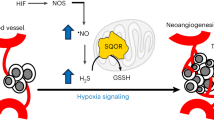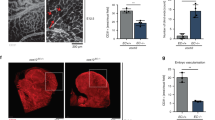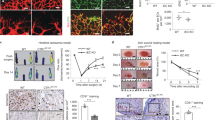Abstract
Reciprocity of inflammation, oxidative stress and neovascularization is emerging as an important mechanism underlying numerous processes from tissue healing and remodelling to cancer progression1,2. Whereas the mechanism of hypoxia-driven angiogenesis is well understood3,4, the link between inflammation-induced oxidation and de novo blood vessel growth remains obscure. Here we show that the end products of lipid oxidation, ω-(2-carboxyethyl)pyrrole (CEP) and other related pyrroles5, are generated during inflammation and wound healing and accumulate at high levels in ageing tissues in mice and in highly vascularized tumours in both murine and human melanoma. The molecular patterns of carboxyalkylpyrroles are recognized by Toll-like receptor 2 (TLR2), but not TLR4 or scavenger receptors on endothelial cells, leading to an angiogenic response that is independent of vascular endothelial growth factor. CEP promoted angiogenesis in hindlimb ischaemia and wound healing models through MyD88-dependent TLR2 signalling. Neutralization of endogenous carboxyalkylpyrroles impaired wound healing and tissue revascularization and diminished tumour angiogenesis. Both TLR2 and MyD88 are required for CEP-induced stimulation of Rac1 and endothelial migration. Taken together, these findings establish a new function of TLR2 as a sensor of oxidation-associated molecular patterns, providing a key link connecting inflammation, oxidative stress, innate immunity and angiogenesis.
This is a preview of subscription content, access via your institution
Access options
Subscribe to this journal
Receive 51 print issues and online access
$199.00 per year
only $3.90 per issue
Buy this article
- Purchase on Springer Link
- Instant access to full article PDF
Prices may be subject to local taxes which are calculated during checkout




Similar content being viewed by others
References
Jackson, J. R., Seed, M. P., Kircher, C. H., Willoughby, D. A. & Winkler, J. D. The codependence of angiogenesis and chronic inflammation. FASEB J. 11, 457–465 (1997)
Coussens, L. M. & Werb, Z. Inflammation and cancer. Nature 420, 860–867 (2002)
Mazzone, M. et al. Heterozygous deficiency of PHD2 restores tumor oxygenation and inhibits metastasis via endothelial normalization. Cell 136, 839–851 (2009)
Fraisl, P., Mazzone, M., Schmidt, T. & Carmeliet, P. Regulation of angiogenesis by oxygen and metabolism. Dev. Cell 16, 167–179 (2009)
Crabb, J. W. et al. Drusen proteome analysis: an approach to the etiology of age-related macular degeneration. Proc. Natl Acad. Sci. USA 99, 14682–14687 (2002)
Karin, M., Lawrence, T. & Nizet, V. Innate immunity gone awry: linking microbial infections to chronic inflammation and cancer. Cell 124, 823–835 (2006)
Martin, P. Wound healing—aiming for perfect skin regeneration. Science 276, 75–81 (1997)
Niethammer, P., Grabher, C., Look, A. T. & Mitchison, T. J. A tissue-scale gradient of hydrogen peroxide mediates rapid wound detection in zebrafish. Nature 459, 996–999 (2009)
Segal, A. W. How neutrophils kill microbes. Annu. Rev. Immunol. 23, 197–223 (2005)
Podrez, E. A. et al. Identification of a novel family of oxidized phospholipids that serve as ligands for the macrophage scavenger receptor CD36. J. Biol. Chem. 277, 38503–38516 (2002)
Podrez, E. A. et al. Platelet CD36 links hyperlipidemia, oxidant stress and a prothrombotic phenotype. Nature Med. 13, 1086–1095 (2007)
Gu, X. et al. Carboxyethylpyrrole protein adducts and autoantibodies, biomarkers for age-related macular degeneration. J. Biol. Chem. 278, 42027–42035 (2003)
Ebrahem, Q. et al. Carboxyethylpyrrole oxidative protein modifications stimulate neovascularization: implications for age-related macular degeneration. Proc. Natl Acad. Sci. USA 103, 13480–13484 (2006)
Manley, P. W. et al. Anthranilic acid amides: a novel class of antiangiogenic VEGF receptor kinase inhibitors. J. Med. Chem. 45, 5687–5693 (2002)
Palm, N. W. & Medzhitov, R. Pattern recognition receptors and control of adaptive immunity. Immunol. Rev. 227, 221–233 (2009)
Kawai, T. & Akira, S. Pathogen recognition with Toll-like receptors. Curr. Opin. Immunol. 17, 338–344 (2005)
Shi, H. et al. TLR4 links innate immunity and fatty acid-induced insulin resistance. J. Clin. Invest. 116, 3015–3025 (2006)
Apetoh, L. et al. Toll-like receptor 4-dependent contribution of the immune system to anticancer chemotherapy and radiotherapy. Nature Med. 13, 1050–1059 (2007)
Kim, H. S. et al. Toll-like receptor 2 senses beta-cell death and contributes to the initiation of autoimmune diabetes. Immunity 27, 321–333 (2007)
Vogl, T. et al. Mrp8 and Mrp14 are endogenous activators of Toll-like receptor 4, promoting lethal, endotoxin-induced shock. Nature Med. 13, 1042–1049 (2007)
Schaefer, L. et al. The matrix component biglycan is proinflammatory and signals through Toll-like receptors 4 and 2 in macrophages. J. Clin. Invest. 115, 2223–2233 (2005)
Jiang, D. et al. Regulation of lung injury and repair by Toll-like receptors and hyaluronan. Nature Med. 11, 1173–1179 (2005)
Grote, K. et al. Toll-like receptor 2/6 stimulation promotes angiogenesis via GM-CSF as a potential strategy for immune defense and tissue regeneration. Blood 115, 2543–2552 (2010)
Zahringer, U., Lindner, B., Inamura, S., Heine, H. & Alexander, C. TLR2—promiscuous or specific? A critical re-evaluation of a receptor expressing apparent broad specificity. Immunobiology 213, 205–224 (2008)
Aliprantis, A. O. et al. Cell activation and apoptosis by bacterial lipoproteins through toll-like receptor-2. Science 285, 736–739 (1999)
Ozinsky, A. et al. The repertoire for pattern recognition of pathogens by the innate immune system is defined by cooperation between toll-like receptors. Proc. Natl Acad. Sci. USA 97, 13766–13771 (2000)
Tan, W. et al. An essential role for Rac1 in endothelial cell function and vascular development. FASEB J. 22, 1829–1838 (2008)
Arbibe, L. et al. Toll-like receptor 2-mediated NF-κB activation requires a Rac1-dependent pathway. Nature Immunol. 1, 533–540 (2000)
Mullick, A. E., Tobias, P. S. & Curtiss, L. K. Modulation of atherosclerosis in mice by Toll-like receptor 2. J. Clin. Invest. 115, 3149–3156 (2005)
Chen, J. et al. Akt1 regulates pathological angiogenesis, vascular maturation and permeability in vivo . Nature Med. 11, 1188–1196 (2005)
Feng, W. et al. The angiogenic response is dictated by β3 integrin on bone marrow-derived cells. J. Cell Biol. 183, 1145–1157 (2008)
Mahabeleshwar, G. H., Somanath, P. R. & Byzova, T. V. Methods for isolation of endothelial and smooth muscle cells and in vitro proliferation assays. Methods Mol. Med. 129, 197–208 (2006)
Acknowledgements
We thank L. Hong for the help with synthesis of CEP and CPP adducts, Y. Cui for expressing and purifying anti-CEP monoclonal antibodies, and J. Crabb for providing anti-CEP monoclonal antibody hybridoma cells. This work was supported by NIH grants HL073311, HL071625, CA126847 to T.V.B., HL077213 to E.A.P. and GM021249 to R.G.S. and an American Heart Association grant (10SDG4300062) to N.L.M.
Author information
Authors and Affiliations
Contributions
N.L.M., E.A.P. and T.V.B. designed experiments. In vivo and ex vivo experiments were performed by X.Z.W. with a help from A.A.M. and M.T. In vitro experiments were performed by N.L.M. with help from B.A.K. Melanoma samples and their analysis was done by E.C.B. Synthesis of CAPs was performed by R.G.S. The data were analysed and plotted by X.Z.W. The manuscript was written by N.L.M. and T.V.B.
Corresponding author
Ethics declarations
Competing interests
The authors declare no competing financial interests.
Supplementary information
Supplementary Figures
This file contains Supplementary Figures 1-14 with legends. (PDF 5905 kb)
Rights and permissions
About this article
Cite this article
West, X., Malinin, N., Merkulova, A. et al. Oxidative stress induces angiogenesis by activating TLR2 with novel endogenous ligands. Nature 467, 972–976 (2010). https://doi.org/10.1038/nature09421
Received:
Accepted:
Published:
Issue Date:
DOI: https://doi.org/10.1038/nature09421
This article is cited by
-
Oxidative stress and docosahexaenoic acid injury lead to increased necroptosis and ferroptosis in retinal pigment epithelium
Scientific Reports (2023)
-
Identification of oxidative stress-related biomarkers associated with the development of acute-on-chronic liver failure using bioinformatics
Scientific Reports (2023)
-
Role of alarmins in poststroke inflammation and neuronal repair
Seminars in Immunopathology (2023)
-
The TLR/MyD88 signalling cascade in inflammation and gastric cancer: the immune regulatory network of Helicobacter pylori
Journal of Molecular Medicine (2023)
-
Ocular surface toll like receptors in ageing
BMC Ophthalmology (2022)
Comments
By submitting a comment you agree to abide by our Terms and Community Guidelines. If you find something abusive or that does not comply with our terms or guidelines please flag it as inappropriate.



